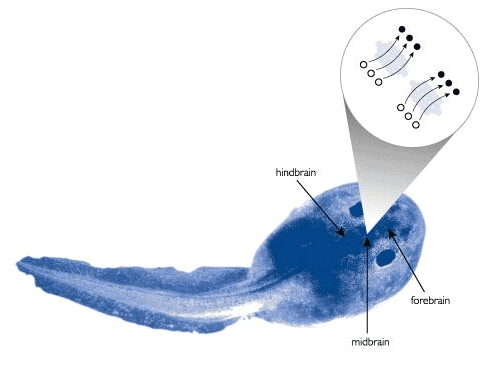Scientists at Cold Spring Harbor Laboratory have found that experimentally altering nitric oxide levels in the developing brain of tadpoles significantly affects brain size and the number of brain cells. The study is significant because it is the first definitive demonstration of the essential role of nitric oxide during vertebrate brain development.
Grigori Enikolopov, the principal investigator on the new study, has previously made several discoveries concerning how the biochemical messenger nitric oxide signals the cells in a developing organism to stop dividing, enabling them to become specialized cell types. These earlier studies using fruit flies and cultured rat nerve cell precursors indicated that controlled production of nitric oxide by cells in an embryo—the right amount at the right time in the right place—is essential for the organism to develop normally.

In the new study, published in the November 15 issue of the Journal of Neuroscience, Enikolopov and his colleagues focused on the role of nitric oxide during brain development. They turned to a favored experimental organism, the South African clawed frog, Xenopus.
When the scientists artificially decreased nitric oxide levels in the brains of developing tadpoles, proliferation of brain cells increased, leading to larger than normal brains. Conversely, when nitric oxide levels were artificially increased, brain cell proliferation decreased, and the resulting brains were smaller than normal.
Enikolopov was joined in this study by Cold Spring Harbor Laboratory researchers Natalia Peunova, Hollis Cline and Vladimir Scheinker.
Most significantly, the scientists discovered an important principle regarding how subtle, localized production of nitric oxide is required for the vertebrate brain to develop normally (see figure below). In the “midbrain” of tadpoles, cells in a particular zone first proliferate and then differentiate as they move toward the sides and front of the brain, where they become specialized cells of the visual system. Enikolopov and his colleagues found that nitric oxide was not produced in the proliferative zone. Instead, nitric oxide was produced in an adjacent layer of cells, perfectly positioned to signal the proliferating cells to stop growing and become specialized visual system cells.
Effect of nitric oxide on visual system development. In the midbrain of tadpoles, unspecialized neurons (white circles) proliferate, move toward the front and side of the brain, and then stop proliferating (black circles). Here, they become specialized neurons which process visual signals from the retina. The unspecialized neurons pass through a zone of cells producing nitric oxide (blue circles), and this is probably how they are signaled to stop proliferating.
In addition to his ongoing studies using fruit flies, tadpoles, and cultured human cells, Enikolopov is currently exploring the role of nitric oxide during mouse development and in hematopoiesis, the process whereby stem cells in bone marrow proliferate and the resulting blood cells differentiate into specialized types (e.g. red blood cells, white blood cells, etc.). Fruit flies, frogs, mice, and humans all have similar sets of enzymes that produce nitric oxide. Thus, Enikolopov and his colleagues are uncovering universal principles concerning the antiproliferative power of nitric oxide and how this power is harnessed to create everything from diverse blood cell types, to correctly proportioned organs, to the complex anatomy of the brain.
Supplemental Information A
Nitric Oxide Named “Molecule of the Year” for 1992
Prior to 1986, nitric oxide (a gas) was known primarily as a precursor of atmospheric “acid rain” and as a toxic component of cigarette smoke. Then, in a startling reversal of fortune, nitric oxide was discovered to be the principle regulator of cardiovascular blood pressure through its natural production within the innermost cells of arteries and its ability to diffuse out of these cells and relax surrounding muscle.
The idea that a gas could act as an endogenous biological messenger in mammals was an entirely new biological concept. This discovery earned Robert Furchgott, Louis Ignarro, and Ferid Murad the Nobel Prize in 1998. Nitric oxide holds the record as the smallest, lightest molecule—and the first gas—known to act as a biological messenger in mammals. The journal Science dubbed nitric oxide its “Molecule of the Year” for 1992. In contrast to the short-term effects of nitric oxide on blood pressure and other processes (see Supplemental Information B), Enikolopov has discovered that nitric oxide has profound long-term effects on cell proliferation that greatly impact the development of many tissues and organs, including the brain.
Supplemental Information B
“Your lips say no, but your NO says yes”
Nitric oxide’s rise to prominence as an important mediator of short-term physiological effects is due not only to its role in global blood pressure regulation, but also to its rather more localized role in regulating the flow of blood to the penis. In response to sexual excitement, neurons in the penis release nitric oxide, which relaxes nearby arterial muscle cells and increases blood flow to the region. Erectile dysfunction is often caused by insufficient nitric oxide production (or response) by the relevant neurons. The anti-erectile dysfunction drug Viagra® acts by amplifying the effect of the available amount of nitric oxide.
Written by: Communications Department | publicaffairs@cshl.edu | 516-367-8455